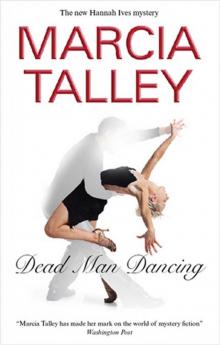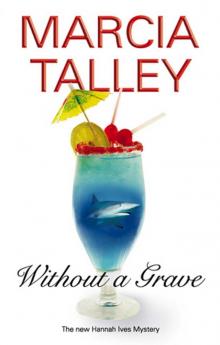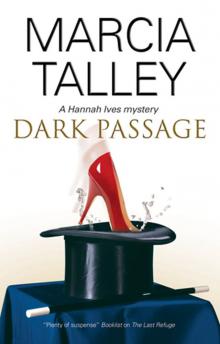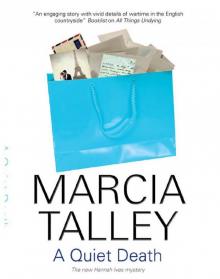- Home
- Marcia Talley
Without a Grave Page 12
Without a Grave Read online
Page 12
Alice in Wonderland appeared deserted, Daniel’s ladder still propped against her hull.
After a quick look around, I stashed my groceries next to an empty trash can and scampered up the ladder. I threw my leg over the lifelines, hopped into the cockpit and crouched down, hardly breathing, feeling about as inconspicuous as a fly on a wedding cake. Tools lay on the cockpit bench where they’d been neatly arranged by one of the workers who had apparently been in the process of installing an autopilot when he broke for lunch. The instrument itself hung half in and half out of the control panel on the steering pedestal, dangling by its wires.
No sirens, no alarms, no shouts of ‘Hey you!’ so I got slowly to my feet and sat down behind the wheel. I remembered my sister-in-law Connie’s sailboat, Sea Song, had its hull identification number stamped into the fiberglass on the stern. Taking a chance I’d not be spotted, I peered over the stern, searching the transom. But if there had ever been any numbers inscribed there, they were gone now.
I needed to look inside.
I hustled down the companionway ladder and found myself standing in a rich, teak-paneled cabin as familiar to me as my own living room: a dinette to port, a galley to starboard, a navigation station to the rear. Many boats were laid out that way, however, even Connie’s.
Where Frank and Sally had a liquor cabinet, there was a microwave, and although our friends had never had a TV, a flat screen hung on the bulkhead of the V-berth in the master cabin.
A stainless-steel cover was drawn over the stove. I checked under it quickly. Three burners. Just like Wanderer, but thousands of other boats, too.
It was the upholstery on the cushions throughout the boat that really got my attention: a distinctive red, green, blue and black tartan. Sally’s maiden name was McDuff. Their dog was named Duffy. Sally’d picked that fabric out herself, the tartan of Clan McDuff. That was proof enough for me.
Jaime Mueller might have been able to hire a crew of Haitians to strip, clean and repaint a boat within a matter of days, I thought, but reupholstering was another matter. I knew from Pattie’s Net bible that there was only one guy in Marsh Harbour who reupholstered boat cushions, and his waiting list was a mile long. He ordered all his fabric from the States, which took forever. Even all of Jaime’s daddy’s money couldn’t turn boat cushions around that fast in the Abacos.
Think, Hannah. If you go to the Marsh Harbour police with your suspicions, they’ll listen politely, then show you the door. Plaid, madam? I could hear the laughter now.
I checked my watch. Daniel and his co-workers would still be at lunch. By my calculations I had twelve minutes, no more, before they came back. Sweat rolled down my cheeks and between my breasts.
There had to be something to prove that this was the Parkers’ boat!
I checked the medicine cabinet. Empty.
I opened the door under the sink where Sally had kept her cleaning supplies. Spotless.
I peeked into the fridge. Not a speck of food.
Someone had scrubbed the stove, too, polishing its stainless-steel surface to a high gloss. Even the oven gleamed. It could have been new.
I leaned back on the stove, and it moved, reminding me of one of my less stellar cruising maneuvers.
Nautical stoves are gimballed. They swing with the motion of the boat, so that pots and pans stay level while you’re cooking under way. I got down on my hands and knees in front of the oven and pushed the stove back, squinting under it into the narrow space between the bottom of the oven and the floor.
On the white fiberglass surface near the back of the stove there was a dark, reddish-brown stain the size of my fist.
I sat back on my heels. Jesus! It had been my fault, that stain. Sally had spaghetti sauce simmering. We girls had been down below, making salad when Wanderer hit a wake and I’d crashed into the stove, sending the pot flying and the sauce splashing over the cook top and dribbling down the side. Apparently, my clean-up had been less than thorough.
Well you see, officer, there was this dried-up spaghetti sauce. Right. That would convince them.
Keep looking.
I pawed through the contents of the navigation station, searching for registration papers, anything that would identify this vessel as Frank and Sally Parker’s boat, Wanderer, but the only contents of the nav station were a 2008 edition of Steve Dodge’s A Cruising Guide to the Abacos, a brand-new logbook, a pair of binoculars and two pens.
I got down on my hands and knees, crawled around the floor, looking for clues, peeping into nooks and crannies not normally peeped into – unless one is falling down drunk – like under the companionway stairs. Nothing, not a scrap.
I lifted the seat cushions and looked under them. Nada. I even pulled up the floorboards and peered into the bilge.
When I sat down on a settee to think, I noticed a drawer in the settee opposite. I pulled the drawer open and when I saw it was empty, pulled it out completely to examine the space behind. Disappointed again, I started to slide the drawer back, but as I did I noticed something written in pencil on the bottom. ‘2304.’ I checked the bottom of the drawer under the settee I had just been sitting on. It also had ‘2304’ penciled on the raw wood. Was it a part number of some sort? Hoping somebody could tell me, I pulled my iPhone out of my fanny pack and took a picture.
I was still puzzled why this boat didn’t seem to have a builder’s plaque. On Connie’s boat, it was nailed to the hatch cover. Where would it be on a Cheoy Lee?
There had been nothing of a plaque-like description in the cockpit. I didn’t find it in my crawl around the interior of Alice in Wonderland. The only objects hanging on the bulkhead were a barometer and a clock, and one of Andy Albury’s smaller half-boat models. From the slightly pitted brass, I could tell that the barometer and the clock had been there forever, but the boat model looked new.
I popped up to the cockpit, grabbed a screwdriver from the array on the bench and quickly backed out one of the screws that held the ship model in place. I loosened the second screw and moved the model to one side.
The model had been hiding two screw holes, about six inches apart, but whatever had been mounted there was gone.
I had to give Jaime Mueller credit. When he stole a boat, he was thorough.
I snapped a picture of the screw holes with my iPhone, reattached the model and got the hell out.
Paul raised both hands. ‘Stop babbling, Hannah.’
I had been going on and on about Wanderer, starting from when I first spotted the vessel in the boatyard, followed by a blow-by-blow description of what led up to my discovery of the spaghetti-sauce spill.
‘Don’t build me a watch, Hannah. Just tell me what time it is.’
‘Alice in Wonderland is Wanderer,’ I sputtered. ‘And I think we can prove it.’
‘Ah.’ Paul laced his fingers together and rested his hands on his chest. ‘The spaghetti-sauce clue.’
‘Don’t be impossible!’ I pawed in my fanny pack for my iPhone, launched the camera icon, and showed Paul the picture of the number written on the bottom of the drawer.
‘2304. What does that mean?’ he asked.
‘I don’t know. I was hoping you’d tell me.’ I flicked forward to the picture of the pair of screw holes I’d discovered in the wall behind the ship model. ‘And here’s where something was removed from the wall. Could have been the builder’s plaque.’
Paul slipped the iPhone out of my fingers and studied the picture closely. ‘Hard to tell from this. Could have been anything mounted up there. “The Captain’s Word is Law” or “Don’t Flush Anything You Haven’t Eaten First.”’
‘Ha ha ha.’ I pinched his ear lobe, hard, then sat down on the sofa. ‘I looked all over the boat for its hull identification number, but couldn’t find one.’
‘I hate to tell you this, Hannah, but boats built in the sixties weren’t required to have hull identification numbers. Wanderer, and this boat, might not even have one.’
‘Bummer,’ I said. Then
I brightened as a thought occurred to me. ‘Do you think Wanderer might have been documented? Can we look it up on the Internet?’ I stood up. ‘Where’s your laptop?’
With Paul’s help, I located the NOAA website where one could search the vessel documentation database by name. I typed in ‘Wanderer,’ pressed Enter, and waited for the results. I sat back, disappointed. ‘Oh, damn. There’s a hundred and seventy-two of them!’
‘It’s a popular name, Hannah. Eric Hiscock sailed three or four Wanderers around the world and wrote books about it. He’s every blue-water dreamer’s hero.’
‘Help me to narrow it down, then. What’s Wanderer’s port of call?’
‘If it’s not Annapolis, I don’t have a clue.’
Only one vessel hailed from Annapolis, and it wasn’t a Cheoy Lee Reliant, but as I scrolled through the display, I realized I could also narrow the search by boat length. Five minutes later I cried, ‘I found it!’ and then, ‘Dammit!’ when I clicked on the record and found that, as Paul had predicted, the space for the hull identification number was blank.
‘Jot down the Coast Guard documentation number,’ Paul suggested. ‘Sometimes owners engrave them on the hull.’
I did as Paul suggested, but didn’t hold out much hope of that. I’d been all over that boat, and if there had been a Coast Guard number anywhere on board, I should have found it.
I stared at the computer screen, chewing my lower lip. ‘What now?’
‘Let’s ask the pro.’ Paul rose from his chair, crossed into the living room and picked up the radio. ‘Dive Gator, Dive Gator, this is Windswept.’ There was no response. After a couple of minutes, he tried again, but Gator was either busy or out of radio range.
‘Sit down and eat your lunch,’ Paul suggested. ‘It’s getting cold.’
‘I’m too upset to eat.’ I tucked my conch burger back into its Styrofoam clamshell and stuck it into the fridge. ‘If Jaime Mueller has Frank and Sally’s boat, then where are Frank and Sally?’
I washed my hands, tried to reach Gator again. This time he replied. ‘What can I do for you, Hannah?’
Since I didn’t want to broadcast my suspicions to everyone who might have been listening in on that channel, I made arrangements to drop by Gator’s office when he returned from his dive.
The afternoon dragged.
I spent some time Googling Cheoy Lee. The company was still in business, but hadn’t made the Reliant since 1976. They built large power yachts now. There appeared to be an active owners’ association, however. I bookmarked both.
Just as I was about to email the Rhodes Reliant and Offshore Forty website, the power failed. I telephoned the Bahamas Electric Company to report the outage. The worker who answered the phone assured me the power would be back in an hour, but with the BEC, that didn’t mean a damn thing. Could be an hour, could be days, depending upon how long it took workers to find and repair the break in the underwater cable. Molly swears they do it with duct tape.
No power, no backup generator, no Internet. Bummer.
Nothing to do but wait.
ELEVEN
THE NATIONAL VESSEL DOCUMENTATION CENTER FACILITATES MARITIME COMMERCE AND THE AVAILABILITY OF FINANCING WHILE PROTECTING ECONOMIC PRIVILEGES OF UNITED STATES CITIZENS THROUGH THE ENFORCEMENT OF REGULATIONS, AND PROVIDES A REGISTER OF VESSELS AVAILABLE IN TIME OF WAR OR EMERGENCY TO DEFEND AND PROTECT THE UNITED STATES OF AMERICA.
Mission Statement, United States Coast Guard,
National Vessel Documentation Center
I found Gator in the cockpit of Deep Magic, slinging empty air tanks on to the dock. I stopped to help.
‘You know that missing sailboat, the Wanderer?’
Gator stopped in mid-swing. ‘Yup.’
‘I think I found it.’
He lowered the tank to the deck and squinted up at me. ‘You’re shitting me. Where?’
‘It’s in Pinder’s boatyard. It’s been stripped and repainted, but I’m pretty sure it’s the same vessel.’ I explained how I knew the Parkers and had sailed on their boat. I told him about the tartan upholstery, the penciled numbers, the telltale screw holes, and even about the spaghetti sauce.
‘Come on. Let’s have a look.’
Faster than I would have thought possible, Gator stepped from Deep Magic to the dock, leaving his boat rocking. He double-timed it up the pier in the direction of his golf cart. By the time I caught up to him, he was already turning the key in the ignition. ‘Hop in.’
The engine sputtered and caught. Gator reached behind his right leg to shove the gear into forward, and we were off. At the boatyard, he brought the cart to a jarring halt in front of the utility shed, hopped out, and motioned for me to follow.
We found Daniel and another Haitian on board the Alice in Wonderland, busily brushing teak oil on the decking.
Gator knocked on the hull until he got Daniel’s attention. ‘Morning, Daniel. Fine boat. Mind if I take a look?’
Daniel beamed down on us. ‘Go ahead, mon.’
The direct approach. Why hadn’t I thought of that?
Gator clambered up the ladder, now propped against the stern of the vessel, and hopped into the cockpit. I followed. While Daniel and his co-worker went on with their task, Gator and I went inside.
If anything, the boat was cleaner than it had been earlier that morning. When I bent over to show Gator the spaghetti-sauce spill, there wasn’t a trace of it, either.
‘Damn.’
The only concrete ‘evidence’ I had left to show him were the numbers penciled on the bottoms of the drawers, and the two screw holes behind the half model where I suspected the builder’s plaque might have been.
While I watched, Gator unscrewed the model and studied the bulkhead behind it, touching a finger to each of the holes, looking thoughtful. He swept his ball cap off his head, and while still holding it, scratched his head. ‘Boat’s so clean you could perform open-heart surgery in here.’
I dredged up a smile. ‘You don’t believe me, do you?’
‘Oh, I believe you,’ he said. ‘That number you found is probably the boat’s yard number. They’d write it on the various components of the boat as they were being built to tell the installer which boat the part was destined for.’
‘Maybe Cheoy Lee kept records?’
‘Maybe.’ He returned the model to its original position and screwed it back down. ‘And Reliants are supposed to have a builder’s plaque right here.’ He tapped the wall with the knuckle of his index finger.
Gator stuck his head out of the hatch and called into the cockpit where one of the Haitians had started polishing up the bright work on the helm. ‘Michael!’
‘Wi?’
‘Kisa bagay vou . . .’ Gator cast his eyes heavenward, as if expecting God to write an English to Creole translation in the clouds. He shifted from one foot to the other uncomfortably. ‘Uh, what thing you take off that wall down there? Konprann?’
At first I thought Michael didn’t ‘konprann,’ but after processing Gator’s question for a few seconds, he shaped his thumbs and fingers into an oval about the size of a saucer.
Gator beamed, and plopped his hat back on his head. ‘Mesi.’
I beamed at Michael, too. ‘Nou ap chache . . .’ Now it was my turn to run out of Creole. I raised both hands, palms up and added, ‘Kote?’ Where?
‘Bokit fatra.’
I looked at Gator. ‘Bokit I get. Bucket. But what’s fatra?’
‘Rubbish, I think.’
‘Trash bin!’ I shouted.
Gator and I practically tripped over one another in our race for the ladder, but only one of us could go down at a time. I descended quickly, backwards, rung by rung, with Gator several rungs behind, trying (vainly) not to step on my fingers.
Once on level ground, Gator pointed toward the stern of Alice in Wonderland. ‘You go that way, and I’ll check the shed area.’
I walked around the boat, looking in every container. I turned up wooden blocks, sandpaper, oil
y rags, bits of fiberglass, but nothing remotely resembling a plaque. I worked my way along the dock, kicking up debris as I went, following the track of the marine railroad down to the water where a school of yellow jacks was nosing about, angling for a handout. In the water I could see lumps of metal, sacrificial leads that had done their duty and disintegrated instead of the propeller shafts to which they had been attached. A few lost screws flashed brightly in the sun.
At the end of the pier, in deeper water, I identified a five-gallon gasoline can, a waterlogged seat cushion green with algae, and what looked like several hatch covers – four-by-four squares of corrugated steel, each tethered to the dock by a rope. As I straightened and opened my mouth to call Gator, he appeared behind me. ‘What are those?’ I asked, pointing to the hatch covers.
‘Lobster condos,’ he replied.
‘Condos? For lobsters?’
‘Traps, actually,’ Gator explained. ‘Those are being seasoned. In a week or two we’ll haul them out to the reef.’
‘How do you catch a lobster with that?’ I wondered aloud. ‘It’s just a flat piece of metal nailed to a couple of two-by-fours.’
‘Lobsters are nocturnal. They hide out in dens during the day. We used to use discarded bathtubs, car hoods, hurricane shutters and the like to make artificial dens for them. As you can see, we’ve gone high-tech.’
I laughed at the concept. ‘So what do you do? Send a diver down, lift up the condo and start grabbing?’
‘Something like that. Lobsters used to be taken by breath-hold divers using spear-guns. Sometimes they’d squirt bleach into the reef to force the lobsters out into the open.’
Thinking about what that would do to the reef, I gasped.
‘Exactly. That’s why it’s now illegal. This method is the least damaging to the reef.’
Gator bent down, picked up one of the ropes and tugged it, raising a corner of the condo so I could see underneath. No lobsters, but I’d hardly expect any in a busy harbor.

 Unbreathed Memories
Unbreathed Memories Tangled Roots
Tangled Roots Dead Man Dancing
Dead Man Dancing Without a Grave
Without a Grave Sing It to Her Bones
Sing It to Her Bones All Things Undying
All Things Undying Naked Came the Phoenix
Naked Came the Phoenix Daughter of Ashes
Daughter of Ashes Footprints to Murder
Footprints to Murder The Last Refuge
The Last Refuge Mile High Murder
Mile High Murder Dark Passage
Dark Passage This Enemy Town
This Enemy Town Tomorrow's Vengeance
Tomorrow's Vengeance Occasion of Revenge
Occasion of Revenge I'd Kill For That
I'd Kill For That A Quiet Death
A Quiet Death